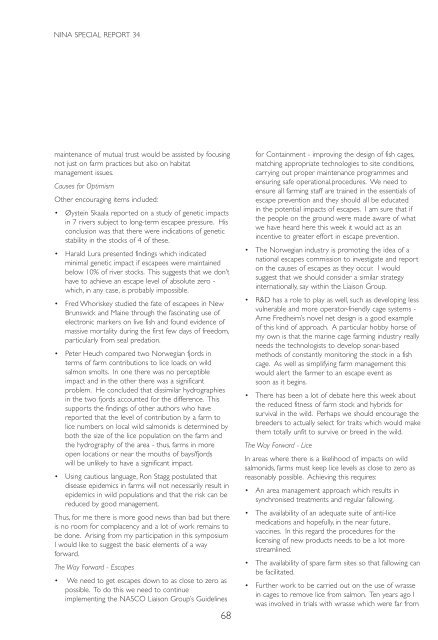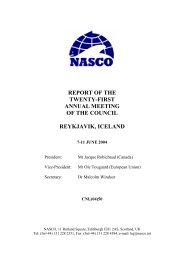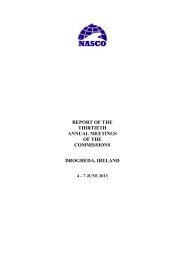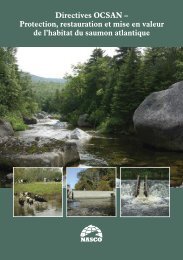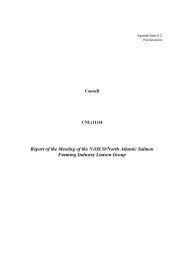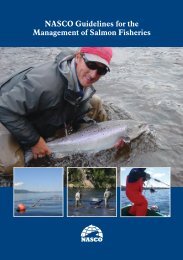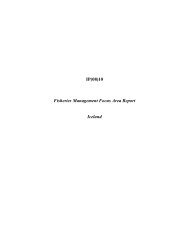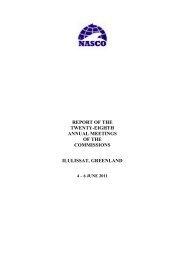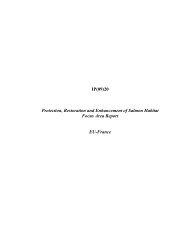Report of the 2005 ICES/NASCO Symposium on Interactions ...
Report of the 2005 ICES/NASCO Symposium on Interactions ...
Report of the 2005 ICES/NASCO Symposium on Interactions ...
Create successful ePaper yourself
Turn your PDF publications into a flip-book with our unique Google optimized e-Paper software.
NINA SPECIAL REPORT 34<br />
maintenance <str<strong>on</strong>g>of</str<strong>on</strong>g> mutual trust would be assisted by focusing<br />
not just <strong>on</strong> farm practices but also <strong>on</strong> habitat<br />
management issues.<br />
Causes for Optimism<br />
O<str<strong>on</strong>g>the</str<strong>on</strong>g>r encouraging items included:<br />
• Øystein Skaala reported <strong>on</strong> a study <str<strong>on</strong>g>of</str<strong>on</strong>g> genetic impacts<br />
in 7 rivers subject to l<strong>on</strong>g-term escapee pressure. His<br />
c<strong>on</strong>clusi<strong>on</strong> was that <str<strong>on</strong>g>the</str<strong>on</strong>g>re were indicati<strong>on</strong>s <str<strong>on</strong>g>of</str<strong>on</strong>g> genetic<br />
stability in <str<strong>on</strong>g>the</str<strong>on</strong>g> stocks <str<strong>on</strong>g>of</str<strong>on</strong>g> 4 <str<strong>on</strong>g>of</str<strong>on</strong>g> <str<strong>on</strong>g>the</str<strong>on</strong>g>se.<br />
• Harald Lura presented findings which indicated<br />
minimal genetic impact if escapees were maintained<br />
below 10% <str<strong>on</strong>g>of</str<strong>on</strong>g> river stocks. This suggests that we d<strong>on</strong>’t<br />
have to achieve an escape level <str<strong>on</strong>g>of</str<strong>on</strong>g> absolute zero -<br />
which, in any case, is probably impossible.<br />
• Fred Whoriskey studied <str<strong>on</strong>g>the</str<strong>on</strong>g> fate <str<strong>on</strong>g>of</str<strong>on</strong>g> escapees in New<br />
Brunswick and Maine through <str<strong>on</strong>g>the</str<strong>on</strong>g> fascinating use <str<strong>on</strong>g>of</str<strong>on</strong>g><br />
electr<strong>on</strong>ic markers <strong>on</strong> live fish and found evidence <str<strong>on</strong>g>of</str<strong>on</strong>g><br />
massive mortality during <str<strong>on</strong>g>the</str<strong>on</strong>g> first few days <str<strong>on</strong>g>of</str<strong>on</strong>g> freedom,<br />
particularly from seal predati<strong>on</strong>.<br />
• Peter Heuch compared two Norwegian fjords in<br />
terms <str<strong>on</strong>g>of</str<strong>on</strong>g> farm c<strong>on</strong>tributi<strong>on</strong>s to lice loads <strong>on</strong> wild<br />
salm<strong>on</strong> smolts. In <strong>on</strong>e <str<strong>on</strong>g>the</str<strong>on</strong>g>re was no perceptible<br />
impact and in <str<strong>on</strong>g>the</str<strong>on</strong>g> o<str<strong>on</strong>g>the</str<strong>on</strong>g>r <str<strong>on</strong>g>the</str<strong>on</strong>g>re was a significant<br />
problem. He c<strong>on</strong>cluded that dissimilar hydrographies<br />
in <str<strong>on</strong>g>the</str<strong>on</strong>g> two fjords accounted for <str<strong>on</strong>g>the</str<strong>on</strong>g> difference. This<br />
supports <str<strong>on</strong>g>the</str<strong>on</strong>g> findings <str<strong>on</strong>g>of</str<strong>on</strong>g> o<str<strong>on</strong>g>the</str<strong>on</strong>g>r authors who have<br />
reported that <str<strong>on</strong>g>the</str<strong>on</strong>g> level <str<strong>on</strong>g>of</str<strong>on</strong>g> c<strong>on</strong>tributi<strong>on</strong> by a farm to<br />
lice numbers <strong>on</strong> local wild salm<strong>on</strong>ids is determined by<br />
both <str<strong>on</strong>g>the</str<strong>on</strong>g> size <str<strong>on</strong>g>of</str<strong>on</strong>g> <str<strong>on</strong>g>the</str<strong>on</strong>g> lice populati<strong>on</strong> <strong>on</strong> <str<strong>on</strong>g>the</str<strong>on</strong>g> farm and<br />
<str<strong>on</strong>g>the</str<strong>on</strong>g> hydrography <str<strong>on</strong>g>of</str<strong>on</strong>g> <str<strong>on</strong>g>the</str<strong>on</strong>g> area - thus, farms in more<br />
open locati<strong>on</strong>s or near <str<strong>on</strong>g>the</str<strong>on</strong>g> mouths <str<strong>on</strong>g>of</str<strong>on</strong>g> bays/fjords<br />
will be unlikely to have a significant impact.<br />
• Using cautious language, R<strong>on</strong> Stagg postulated that<br />
disease epidemics in farms will not necessarily result in<br />
epidemics in wild populati<strong>on</strong>s and that <str<strong>on</strong>g>the</str<strong>on</strong>g> risk can be<br />
reduced by good management.<br />
Thus, for me <str<strong>on</strong>g>the</str<strong>on</strong>g>re is more good news than bad but <str<strong>on</strong>g>the</str<strong>on</strong>g>re<br />
is no room for complacency and a lot <str<strong>on</strong>g>of</str<strong>on</strong>g> work remains to<br />
be d<strong>on</strong>e. Arising from my participati<strong>on</strong> in this symposium<br />
I would like to suggest <str<strong>on</strong>g>the</str<strong>on</strong>g> basic elements <str<strong>on</strong>g>of</str<strong>on</strong>g> a way<br />
forward.<br />
The Way Forward - Escapes<br />
• We need to get escapes down to as close to zero as<br />
possible. To do this we need to c<strong>on</strong>tinue<br />
implementing <str<strong>on</strong>g>the</str<strong>on</strong>g> <str<strong>on</strong>g>NASCO</str<strong>on</strong>g> Liais<strong>on</strong> Group’s Guidelines<br />
68<br />
for C<strong>on</strong>tainment - improving <str<strong>on</strong>g>the</str<strong>on</strong>g> design <str<strong>on</strong>g>of</str<strong>on</strong>g> fish cages,<br />
matching appropriate technologies to site c<strong>on</strong>diti<strong>on</strong>s,<br />
carrying out proper maintenance programmes and<br />
ensuring safe operati<strong>on</strong>al.procedures. We need to<br />
ensure all farming staff are trained in <str<strong>on</strong>g>the</str<strong>on</strong>g> essentials <str<strong>on</strong>g>of</str<strong>on</strong>g><br />
escape preventi<strong>on</strong> and <str<strong>on</strong>g>the</str<strong>on</strong>g>y should all be educated<br />
in <str<strong>on</strong>g>the</str<strong>on</strong>g> potential impacts <str<strong>on</strong>g>of</str<strong>on</strong>g> escapes. I am sure that if<br />
<str<strong>on</strong>g>the</str<strong>on</strong>g> people <strong>on</strong> <str<strong>on</strong>g>the</str<strong>on</strong>g> ground were made aware <str<strong>on</strong>g>of</str<strong>on</strong>g> what<br />
we have heard here this week it would act as an<br />
incentive to greater effort in escape preventi<strong>on</strong>.<br />
• The Norwegian industry is promoting <str<strong>on</strong>g>the</str<strong>on</strong>g> idea <str<strong>on</strong>g>of</str<strong>on</strong>g> a<br />
nati<strong>on</strong>al escapes commissi<strong>on</strong> to investigate and report<br />
<strong>on</strong> <str<strong>on</strong>g>the</str<strong>on</strong>g> causes <str<strong>on</strong>g>of</str<strong>on</strong>g> escapes as <str<strong>on</strong>g>the</str<strong>on</strong>g>y occur. I would<br />
suggest that we should c<strong>on</strong>sider a similar strategy<br />
internati<strong>on</strong>ally, say within <str<strong>on</strong>g>the</str<strong>on</strong>g> Liais<strong>on</strong> Group.<br />
• R&D has a role to play as well, such as developing less<br />
vulnerable and more operator-friendly cage systems -<br />
Arne Fredheim’s novel net design is a good example<br />
<str<strong>on</strong>g>of</str<strong>on</strong>g> this kind <str<strong>on</strong>g>of</str<strong>on</strong>g> approach. A particular hobby horse <str<strong>on</strong>g>of</str<strong>on</strong>g><br />
my own is that <str<strong>on</strong>g>the</str<strong>on</strong>g> marine cage farming industry really<br />
needs <str<strong>on</strong>g>the</str<strong>on</strong>g> technologists to develop s<strong>on</strong>ar-based<br />
methods <str<strong>on</strong>g>of</str<strong>on</strong>g> c<strong>on</strong>stantly m<strong>on</strong>itoring <str<strong>on</strong>g>the</str<strong>on</strong>g> stock in a fish<br />
cage. As well as simplifying farm management this<br />
would alert <str<strong>on</strong>g>the</str<strong>on</strong>g> farmer to an escape event as<br />
so<strong>on</strong> as it begins.<br />
• There has been a lot <str<strong>on</strong>g>of</str<strong>on</strong>g> debate here this week about<br />
<str<strong>on</strong>g>the</str<strong>on</strong>g> reduced fitness <str<strong>on</strong>g>of</str<strong>on</strong>g> farm stock and hybrids for<br />
survival in <str<strong>on</strong>g>the</str<strong>on</strong>g> wild. Perhaps we should encourage <str<strong>on</strong>g>the</str<strong>on</strong>g><br />
breeders to actually select for traits which would make<br />
<str<strong>on</strong>g>the</str<strong>on</strong>g>m totally unfit to survive or breed in <str<strong>on</strong>g>the</str<strong>on</strong>g> wild.<br />
The Way Forward - Lice<br />
In areas where <str<strong>on</strong>g>the</str<strong>on</strong>g>re is a likelihood <str<strong>on</strong>g>of</str<strong>on</strong>g> impacts <strong>on</strong> wild<br />
salm<strong>on</strong>ids, farms must keep lice levels as close to zero as<br />
reas<strong>on</strong>ably possible. Achieving this requires:<br />
• An area management approach which results in<br />
synchr<strong>on</strong>ised treatments and regular fallowing.<br />
• The availability <str<strong>on</strong>g>of</str<strong>on</strong>g> an adequate suite <str<strong>on</strong>g>of</str<strong>on</strong>g> anti-lice<br />
medicati<strong>on</strong>s and hopefully, in <str<strong>on</strong>g>the</str<strong>on</strong>g> near future,<br />
vaccines. In this regard <str<strong>on</strong>g>the</str<strong>on</strong>g> procedures for <str<strong>on</strong>g>the</str<strong>on</strong>g><br />
licensing <str<strong>on</strong>g>of</str<strong>on</strong>g> new products needs to be a lot more<br />
streamlined.<br />
• The availability <str<strong>on</strong>g>of</str<strong>on</strong>g> spare farm sites so that fallowing can<br />
be facilitated.<br />
• Fur<str<strong>on</strong>g>the</str<strong>on</strong>g>r work to be carried out <strong>on</strong> <str<strong>on</strong>g>the</str<strong>on</strong>g> use <str<strong>on</strong>g>of</str<strong>on</strong>g> wrasse<br />
in cages to remove lice from salm<strong>on</strong>. Ten years ago I<br />
was involved in trials with wrasse which were far from


